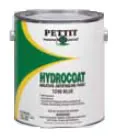
There are two schools of thought when it comes to applying antifouling paint to an inflatable-bottom dinghy (as opposed to a RIB, which has a fiberglass bottom).
We’re of the “don’t-do-it” camp for a few reasons. First, once bottom paint is applied to your dinghy, it can be very difficult to remove it without risking damage to the material. Second, if you ever store the dinghy on deck or deflate it for longer storage, you can be sure that paint is going to rub off on things you’d rather it not foul—for instance, tacking headsails, topsides, or the deck.
Even if you leave the dinghy in the water for long periods of time without use, cleaning the bottom regularly should be enough to keep barnacles at bay.
If you have your heart set on applying antifouling to an inflatable (PVC or Hypalon), there are several options available. All of the so-called inflatable bottom paints are water-based, flexible coatings. Pettit Hydrocoat, Pettit Inflatable Boat Antifouling Paint, Interlux Fiberglass Bottomkote Aqua, and Sea Hawk Inflatable bottom paint (www.seahawkpaints.com) are just some of the options.
Practical Sailor editors’ past experiences in the field with Pettit’s Inflatable Boat paint (www.pettitpaint.com) and Hydrocoat have been good, although we have seen the paint smear onto other surfaces. Hydrocoat is flexible and adheres well to PVC and Hypalon, but because it is an ablative paint, it also can easily rub off.
In past bottom paint panel tests, Fiberglass Bottomkote Aqua—a multi-season hard paint—has fared well after one year of panel testing. Hydrocoat, a multi-season ablative, also has done well.
In our most recent tests, one of Sea Hawk’s standout paints was Inflatable, a “hard” ablative paint for inflatable boats, which still rated Fair at 24 months.
If the dinghy is to be stored on davits, or out of the water for any length of time, Interlux (www.yachtpaint.com) recommends using its Micron paints, which retain their antifouling properties in and out of the water. We’ve also had this paint rub off when the dinghy is stored on deck. Interlux warns against using a vinyl antifouling—such as its VC Offshore or Regatta Baltoplate Racing—on Hypalon.
If you have another paint in mind, contact the manufacturer to be sure it’s appropriate for an inflatable. Be sure to clean the area thoroughly with a maroon Scotchbrite pad for better paint adhesion, and always follow manufacturer’s instructions.





































